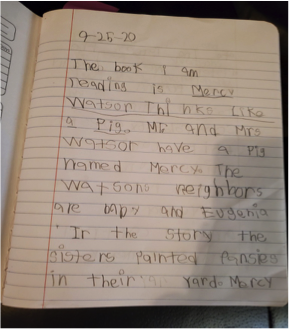On a recent afternoon, a few colleagues and I actually had time to catch our breath after many weeks of adjusting to our ever-changing lives here at school. One of them shared that they were struggling with having their students fully engage with Individualized Daily Reading (IDR) in our current hybrid model. This has been a challenge that many teachers have expressed since we left our traditional school model last spring.
One thing that my colleagues and I love is a good challenge. The synergy that happens when we share ideas moves us quickly from spending time admiring a problem to seeking a solution. As we began to strategize, we came up with the following generative ideas for effective IDR in a virtual setting:
- Create digital anchor charts. Students rely on the anchor charts that are generated during Making Meaning Creating digital anchor charts on a platform such as Padlet allows students to access these tools as they read independently at home.
- Plan for IDR during some of your synchronous time. The dialogue between readers before and after reading is such an important component of building our reading communities and holds students accountable for doing the thinking about their own text, just as it does in the read-aloud setting.
- Use the camera! Have students tip their screens down so that you can see what students are reading and how they are attending to the reading. This camera placement also allows them to watch each other reading much like they would in the classroom.
- Consider engaging students in a stop and jot during IDR. One teacher shared that she sends home sticky notes in student “Go Bags” so that she can have the students stop and jot to keep them engaged. She shared that her students were currently in the Wondering unit. Their stop and jots for this week center on jotting questions they have as they move through their texts. (See the Making Meaning Remote Learning Guidance document located in the Professional Learning/Implementation Tab on the Learning Portal.)
- Create space for sharing. Students miss interactions with other students. Create “Book Buzz” breakout rooms where students can share books they are enjoying with each other.
- Blog about it! Maximize opportunities for students to engage in discourse about the texts that they are reading. You might consider allowing time and space for students to form small book clubs. A blogging format allows students to share their thinking and respond to the thinking of others.
- Keep conferences alive. Not only are conferences a powerful instructional opportunity, but just as importantly, they help us build our relationships with our students. Consider that conferences do not have to always be one-on-one. We might want to schedule partner or small group conferences depending on the goals our readers are working on. (To learn more about IDR conferences, read the blog, “Stacey Abeyta’s Continued Reflection on IDR Conferences.”)
- Preview your upcoming Making Meaning Plan for ways to get books that align with the unit you will be teaching into the hands of your students. Access resources such as your local library, Epic!, Oxford Owl, or Amazon free e-books to help you and your students find books that are of interest to them. (To learn more about planning for Making Meaning, read the blog, “Planning for Making Meaning Instruction.”)
- Listen! Have students record themselves reading the book they will be talking about in their upcoming conference. When we can hear students read prior to a conference, it helps us plan for what we might say when we talk about reading goals together.
- Read and write together! One teacher shared that she has some students read for 10 minutes in a breakout room and then respond to their reading for about 10 minutes in their reader’s response journals. This is their independent work until she can meet with them. The small groups hold each other accountable. One student sets a timer for the group and they remind each other to keep working.

In our virtual world, every day brings something new. We will continue to share with and learn from one another, improving our craft each step of the way. One thing we know for sure—as teachers, we can do hard things! We have courage. We have each other. We will figure this out.
